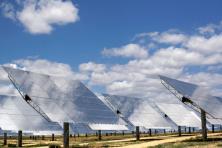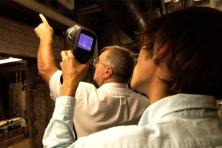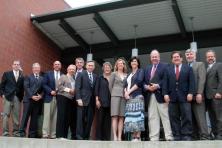Early in 2009, former World Bank President James Wolfensohn, spoke at a fundraising dinner in Jackson, WY (population 9,915), where he challenged Mayor Mark Barron to transform Jackson into a model of energy efficiency to the world.
Wolfensohn, who considers Jackson his home, told Mayor Barron that he was willing to lend his leadership and financial support to Jackson’s efforts to pioneer energy efficiency and clean energy solutions.
Putting Jackson on the Energy Innovation Map: Mayor Barron immediately created the Wolfensohn Challenge Steering Committee, composed of officials representing the Town, Teton County, Lower Valley Energy (LVE), (the rural cooperative utility that serves the area), a representative from the Governor’s office, as well as other influential local leaders. The Committee raised nearly $350,000 in private donations to support Jackson's initial efforts to embrace clean energy.
The Town of Jackson used Energy Efficiency Conservation Block Grant funding to work with Climate Solutions’ New Energy Cities program to create the Jackson Hole Energy Sustainability Project (JHESP), whose mission is to make Jackson a national leader in energy efficiency and energy innovation and a model for sustainability, cost savings, and conservation.
Setting Specific Goals with Metrics: With grant money from a local charitable organization, 1% for the Tetons, the JHESP performed a county-wide greenhouse gas emissions inventory and then, working with the community and facilitated by the New Energy Cities team, set the following specific goals:
- Reduce by at least 33 percent the additional 30 megawatts of energy needed to meet the area’s projected load growth for the next 20 years through resource conservation
- Develop local renewable energy resources to generate at least two megawatts of additional energy over the next 20 years
- Achieve at least an 80 percent penetration rate for energy efficiency building retrofits
- Encourage and advocate for adoption of building codes that require maximum energy efficiency for future buildings and infrastructure
- Share the message of energy efficiency and care for the region’s special environment with the millions of visitors who come to Jackson and the Yellowstone ecosystem
In the three years since the Wolfensohn Challenge got underway, the JHESP has made considerable progress toward these goals.
Governance Agreement with Utility: First, the JHESP reached a tri-partite governance agreement between the Town, the County, and LVE, which formalized the JHESP’s authority to oversee projects and make key decisions about financing. Supported by members of the Town, County, and LVE staff for the first two years of operation, the JHESP hired a full-time Executive Director in 2011. Also in 2011, the JHESP became a Joint Powers Board of the Town and County managed by nine board members.
Using the Ballot and Legislature to Enable Improvements: As part of a public buildings energy efficiency retrofit strategy, the JHESP ran a successful ballot measure in August 2010, asking voters for $3.7 million in Special Purpose Excise Tax monies to upgrade the public facilities of the community. Quite a feat during the deepest recession the nation has seen since 1929.
Legislation to Permit Energy Efficiency: Because the Wyoming constitution prevents public money from being loaned to private parties and citizens, the JHESP hired the Boulder, Colorado law firm of Kutak Rock LLP to provide advice on changing these restrictions for retrofits. This work resulted in the successful passage of HB0179, sponsored by Wyoming Representative Ruth Ann Petroff, which permits the JHESP to designate energy improvement areas and establish loan programs for cost-effective energy upgrades and energy audits for property owners within the areas.
The State of Wyoming Steps Up: The Town also received $572,000 from LVE in energy rebate funds as a reward for energy efficient upgrades made to the aeration system of Jackson’s wastewater treatment plant.
For its residential energy efficiency retrofit program, the JHESP analyzed data to determine the payback and return on investment on an energy efficiency and smart metering pilot project for up to 300 buildings in Jackson.
The JHESP applied for and received a $1,500,000 loan from the State of Wyoming Energy Office to provide an energy efficiency loan program in the community. Loans of up to $7,500 are offered at zero percent; loans of up to $20,000 are available at varying interest rates. Loans must be repaid in five years, and payments appear on the customers’ monthly utility bills.
Residents can use loans for installation of windows, insulation, smart thermostats, caulking and weather stripping, fuel switching from electricity to gas, solar panels, solar hot water heaters, ground source heat pumps, home natural gas fueling stations for vehicles, energy efficient furnaces, and heat recovery ventilation systems.
Community Engagement and Outreach: The JHESP focused significant attention on communications by developing a community outreach and education strategy, creating a website that monitors all JHESP activities, and keeping an active presence at all community events where the efforts of the JHESP could be promoted. The JHESP hosted the Jackson Eco Fair on May 12, 2012, for example, sharing information about its mission and the importance of energy auditing and energy efficiency with nearly 2,500 attendees in Powerhorn Park, in the center of Jackson.
Knowing the importance of engaging and educating property owners about energy efficiency retrofits, the JHESP partnered with the University of Wyoming to conduct a community survey gauging local attitudes toward energy retrofits in homes, while LVE engaged homeowners in a Smart Grid pilot program related to water heater usage.
Largest Solar Array in the State: By the fall of 2011, the JHESP has exceeded its renewable energy goal of two megawatts by building the largest solar array in the State of Wyoming—four megawatts—on the Town’s Wastewater Treatment facility. The JHESP plans to expand the array to five megawatts.
The Town of Jackson is well on its path to becoming a national leader in energy efficiency and renewable energy. With over four million annual visitors to the area, Jackson has the potential to educate millions of Americans about the value of investing in energy efficiency and renewable energy and pioneering a clean energy future.
JACKSON INNOVATIONS
- Created a formal collaboration between the utility, the Town, and the County to reduce energy
- Set aggressive, measurable goals to reduce energy usage throughout the community in order to meet projected load growth and to supplement energy demand with renewable growth
- Ran a ballot measure to raise public money for retrofitting public buildings
- Passed legislation in the Wyoming State Legislature enabling the creation of energy improvement districts
- Developed a strategy for residential retrofits and created a $1.5 million loan loss reserve fund
For more examples of city-led clean energy innovation, please read the New Energy Cities report, Powering the Clean Energy Future from the Ground Up: Profiles in City-Led Clean Energy Innovation.



